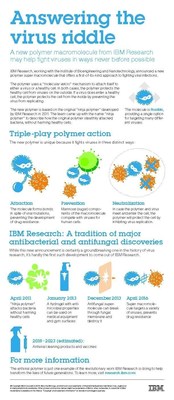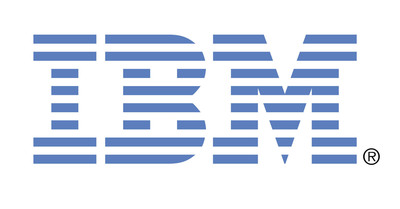ARMONK, N.Y. and SINGAPORE, May 11, 2016 /PRNewswire/ -- As one of medicine’s largest challenges, viral infections often escape vaccines due to their natural ability to mutate rapidly and develop drug resistance easily. Many viruses, such as Zika, Ebola and dengue fever, have grown into major global health epidemics with great human and economic toll. Today, IBM Research (NYSE: IBM) and Singapore’s Institute of Bioengineering and Nanotechnology (IBN) announced that they have identified a new breakthrough macromolecule that could help prevent deadly virus infections with a unique triple-play mechanism that can also help prevent viral drug resistance.

The study exploits supramolecular chemistry the study of large molecules designed with multiple features -- to help combat viral infection. The research is believed to be a first of its kind in fighting viral diseases and IBM Watson, along with such experimental breakthroughs, could help further accelerate drug discovery.
A Unique Triple-Play Action that Helps Prevent Drug Resistance
The new macromolecule is composed of several specialized components to create a powerful triple-play action that helps fight viral infection and replication while inhibiting drug resistance.
- Attraction - One specialized component of the macromolecule enables strong hydrogen bonds with electrostatic interactions to attract the proteins on the virus surface -- disabling viral ability to infect healthy cells.
- Prevention - Mannose (a type of sugar) components of the macromolecule bind directly to healthy immune cell receptors to help fight viral infection and allow the free flow of these naturally protective cells.
- Neutralization - Another component of the macromolecule, known as basic amine groups, neutralize the pH inside the viral cell making it inhospitable for replication.
Additionally, the researchers aimed to design a very flexible macromolecule and surveyed a variety of representative viruses from various categories, including Ebola, dengue, Marburg, influenza, Chikungunya, Enterovirus 71 and herpes simplex. In early testing, scientists have seen no resistance. Also, by targeting both viral proteins and hostvirus interactions, the antiviral macromolecule sidesteps the normal mutations that enable viruses to escape vaccines through the onset of resistance.
“With the recent outbreak of viruses such as Zika and Ebola, achieving anti-viral breakthroughs becomes even more important,” said Dr. James Hedrick, lead researcher, advanced organic materials, IBM Research Almaden, San Jose, Calif. “We are excited about the possibilities that this novel approach represents, and are looking to collaborate with universities and other organizations to identify new applications.”
The Potential to Combat Disease
The short-term potential could be for applications such as an anti-viral wipe or detergent, which would require a small amount of the macromolecule dispersed in water to potentially neutralize an entire room infected with Ebola, for example. Potential longer-term applications may include the development of a new mode of vaccination that could help prevent a whole category of viral infections.
“Viral diseases continue to be one of the leading causes of morbidity and mortality,” said Dr. Yi Yan Yang, Group Leader, Institute of Bioengineering and Nanotechnology, Singapore. “We have created an anti-viral macromolecule that can tackle wily viruses by blocking the virus from infecting the cells, regardless of mutations. It is not toxic to healthy cells and is safe for use. This promising research advance represents years of hard work and collaboration with a global community of researchers.”
Additional IBM cognitive computing tools can carry this initial research further. For example, as this macromolecule progresses to the clinical trial stage, IBM Watson Discovery Advisor can draw connections between disparate data sets to speed new insights. Enabled by cognitive computing, IBM Watson for Clinical Trial Matching enhances clinicians’ ability to easily find clinical trials for which a patient may be eligible, increases the likelihood that the patient is offered the option of a clinical trial for treatment and helps increase clinical trial fulfillment through effective patient recruitment.
The full research paper, Cooperative Orthogonal Macromolecular Assemblies with Broad Spectrum Antiviral Activity, High Selectivity, and Resistance Mitigation, was recently published in the peer-reviewed journal Macromolecules.
Resources
Infographic: https://www.flickr.com/photos/ibm_research_zurich/albums/72157667153581070
About IBM Research
For more than seven decades, IBM Research has defined the future of information technology with more than 3,000 researchers in 12 labs located across six continents. Scientists from IBM Research have produced six Nobel Laureates, 10 U.S. National Medals of Technology, five U.S. National Medals of Science, six Turing Awards, 19 inductees in the National Academy of Sciences and 20 inductees into the U.S. National Inventors Hall of Fame. For more information about IBM Research, visit www.ibm.com/research.
Institute of Bioengineering and Nanotechnology (IBN)
The Institute of Bioengineering and Nanotechnology (IBN) is the world’s first bioengineering and nanotechnology research institute. Established in 2003, IBN’s mission is to conduct multidisciplinary research across science, engineering, and medicine for breakthroughs to improve healthcare and quality of life. IBN’s research activities are focused on Nanomedicine, Synthetic Biosystems, Biodevices and Diagnostics, and Green Chemistry and Energy. The Institute has published over 1,100 papers in leading scientific journals, filed over 550 active patents and patent applications on its inventions, and established 10 spin-off companies. To nurture young research talents, IBN runs a Youth Research Program that offers students research attachment opportunities and exposure to biomedical research. For more information on IBN, please visit www.ibn.a-star.edu.sg.
Media Contacts
Caroline Yu Vespi
External Relations
IBM Research Almaden
+1 925 212 9184
cvespi@us.ibm.com
Nidyah Sani
Corporate Communications
Institute of Bioengineering and Nanotechnology
+65 6824 7005
nidyah@ibn.a-star.edu.sg

Photo - http://photos.prnewswire.com/prnh/20160510/366107-INFO
Logo - http://photos.prnewswire.com/prnh/20090416/IBMLOGO
To view the original version on PR Newswire, visit:http://www.prnewswire.com/news-releases/scientists-discover-new-technology-breakthrough-in-fighting-viral-diseases-300266695.html
SOURCE IBM





